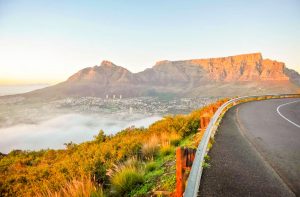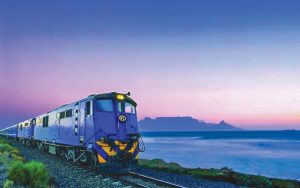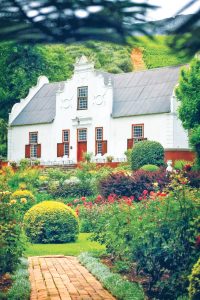South Africa – A Land of Extremes
Article by Joe Gschwendtner; courtesy photos

The view of Table Mountain in Cape Town; courtesy of sapeople.com.
Thirty years ago, I read James A. Michener’s historical fiction novel about South Africa, The Covenant. I knew immediately that I had to visit the country. It was the trip of a lifetime, at least at the time. It was and remains a land of exquisite beauty and cruelty, extreme wealth and despair.
For an adventure, South Africa offered everything, and still does. The country is that rare, incomprehensible treasure that can satisfy the most discriminating of travelers. Travelers can expect wildlife, first-world highways, Cape-Dutch architecture, artisan quality wines, beguiling beauty, a polyglot culture and much, much more. A gourmet menu with something for every appetite. We enjoyed it all first class, sampling it by train and rental car.
All of it is still available today, provided one plans ahead. The state department issues reports on current conditions and traveler risk assessments. Apprise yourself of them. Solo trips like ours may be ill-advised today. Tours provide extra margins of safety and security.
Though never having reached Durban on the Indian Ocean, we sampled Johannesburg, Cape Town and Pretoria. We also took the Garden Route north along the lower east coast, hip-hopping and bed and breakfasting through wine country. Johannesburg was huge, appealing only in small enclaves, a necessity only as a starting point. Barely worth a day, really.
Cape Town and environs, on the other hand, was enthralling, especially with Table Mountain in the background. One cannot go visit without appreciating the two contrasting Goliaths, sandwiching the town, the mountains meeting the sea. It was the original site of the “Company’s Garden” of Jan van Riebeeck, a man charged with growing victuals for Dutch East India Company expeditions. The Cape of Good Hope, just to the south, is that unusual place where east meets west. Unusual flora, fauna and monkeys abound, the latter clowns really, with a great show for visitors.
Pretoria, South Africa’s administrative capital, is chock-full of history with several monuments chronicling the history of early settlers known as “Voortrekkers.” The jacaranda trees, brought in from Argentina, are beyond magnificent.

The luxury rail experience known as The Blue Train with Table Mountain in the backdrop, courtesy of the Daily Telegraph.
Traveling the country’s spine, we enjoyed The Blue Train, an ultra-luxury rail experience, redolent of a bygone era. Still operating today, the price is approximately $1,145 per person or $1.15 per rail mile over a 31-hour journey. By all accounts, the journey remains exquisite, full of creature comforts and gourmet accoutrements.
On our own, we visited the many preserves and national parks that, but for Kruger, exist to cultivate and sustain certain animals. In our case, we accessed zebra and elephant havens and private reserves for ostrich. When so inclined, ostrich rides are available. Ostrich steak is also a common restaurant offering.

Dutch “Cape” architecture in the Stellenbosch region, courtesy of depositosantamariah.blogs.
Kruger National Park is the ultimate game park; one enters only with tight restrictions. Animals still roam freely and yes, there are lions and tigers. Private reserves like Rattray abound, with unique insights and native trackers intimate with wild Africa. One day, eyes closed, while sunning myself at the pool, I experienced an unscheduled eclipse. Opening my eyes, I discovered it was actually a giraffe crossing between me and the sun.
The Republic is still unsettled and unfulfilled. South Africa is still a popular place, but there are above average risks facing the unescorted tourist. On balance though, she is the jewel of the continent.